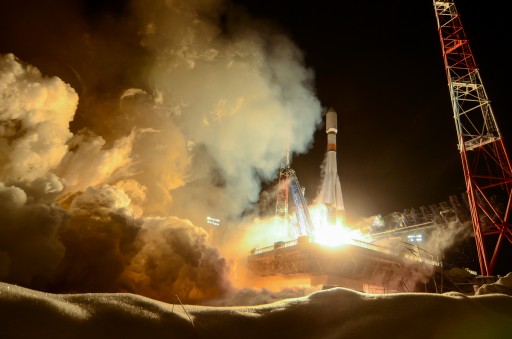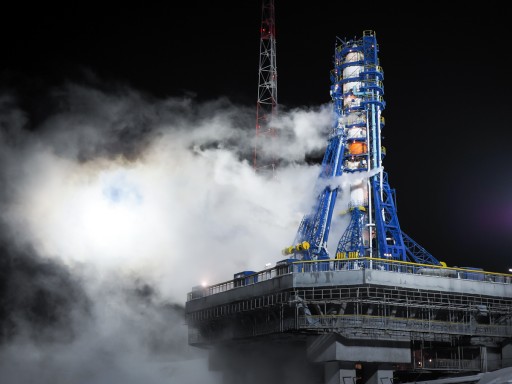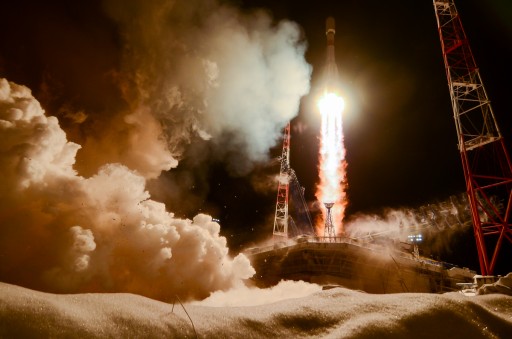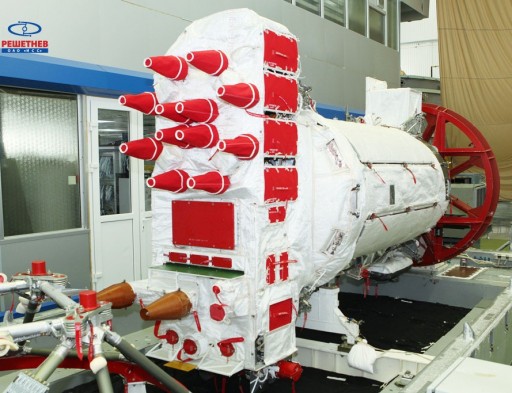Glonass Navigation Constellation Replenishment Mission reaches target Orbit

Russia became the third country to send a navigation satellite into orbit this week when a Soyuz rocket blasted off from the Plesetsk Cosmodrome at 0:21 UTC on Sunday on a critical mission to replenish Russia’s Glonass Satellite Navigation Constellation. This launch followed a Beidou-3 navigation satellite from China and the U.S. Air Force launching the final block IIF Global Positioning System Satellite earlier in the week.
Climbing into the night skies over Russia’s primary military launch site, the 46-meter tall Soyuz swung to the south-east powered by its four boosters and large core stage, delivering a total launch thrust of over 420 metric-ton-force. Doing the majority of the work during the early ascent phase, the four boosters separated from the rocket two minutes into the flight after each consumed nearly 40 metric tons of propellant. Soyuz relied on its core stage to head on towards space, powered by an RD-108A engine to generate a vacuum thrust of 101 metric tons. Payload fairing separation occurred late in the core stage’s burn.
Handing off to the modified Block I third stage, the core stage departed the vehicle in the typical hot staging sequence with third stage ignition a short moment before the separation system fired. Employing the improved RD-0124 engine, the third stage of the Soyuz 2-1B variant delivers 30 metric tons of thrust for a burn of over four minutes to boost the stack to a sub-orbital trajectory.


The Fregat-M upper stage was sent on its way nine and a half minutes into the flight to begin a three-burn mission taking around three and a half hours. First, the upper stage was tasked with a short main engine burn to enter a Low Earth Parking Orbit just over 200 Kilometers in altitude ahead of a short coast phase to set up the proper apogee position reached by the second burn. The second firing of the 19.85-Kilonewton S5.92 engine was expected to last around nine and a half minutes and place the stack into an elliptical transfer orbit with an apogee over 19,000 Kilometers in altitude.
Next was the longest coast of the mission, over three hours in duration to enable the vehicle to climb all the way to the high point of the orbit so that a propulsive impulse could raise the perigee and circularize the orbit. This third burn was just shy of four minutes in duration and aimed for an orbit of around 19,130 Kilometers, inclined 64.8°. A successful orbital insertion and spacecraft separation was confirmed by the Russian Ministry of Defence around four hours after liftoff.
On its way downrange, the ascending Fregat stage almost crossed paths with the North Korean Kwangmyongsong-4 satellite that was launched just eight minutes after Soyuz lifted off. Given the south-easterly trajectory of the Glonass launch, the vehicles came to within a few hundred Kilometers of each other shortly after the North Korean satellite had entered orbit.
The Joint Space Operations Center issued the following orbital parameters for the Glonass-M No. 51 satellite in a very precise orbit and the spent Fregat Upper Stage after a pair of disposal maneuvers:
2016-008A - 19,132 x 19,158 km - 64.80° [Glonass-M No. 51] 2016-008B - 19,156 x 19,464 km - 64.78° [Fregat-M R/B]

The 1,500-Kilogram Glonass satellite will be phased into Plane 3 of the satellite constellation that had been hit by a spacecraft failure in 2014 when a six-year old Glonass-M satellite stopped operating, requiring the operational spare to be placed into primary mode. A surprise failure of a spacecraft in 2015 after only four years in active service required operators to re-activate a degraded spacecraft that had already been placed into retirement. This aged satellite eventually failed in October after nearly ten years in orbit, exceeding its expected lifetime by three years.
These failures left Plane 3 of the constellation with only seven instead of eight operational satellites and plans were put in motion to ready one of nine Glonass-M satellites in ground storage for launch. Originally planned before the end of the year, the mission had to be pushed to February.
The other two orbital Planes of the Glonass constellation each host eight operational spacecraft, including several satellites that are either about to or have already exceeded their planned seven-year service lives.
In recent years, the Glonass program shifted to a launch-on-need architecture as a cost-saving measure – only launching satellites when spacecraft in orbit are showing signs of degradation and need to be replaced instead of launching satellites on a fixed schedule and ending up with more satellites in orbit than actually needed. With an architecture similar to the U.S. Global Positioning System, Glonass requires 24 active spacecraft in three orbital planes with one spare desired per plane to ensure a continuity of service in the event of a problem with one spacecraft.

